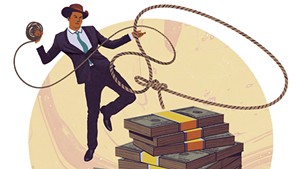
- Courtesy Of The University Of Vermont Medical Center
- The University of Vermont Medical Center
Vermont's three largest hospitals are projecting tens of millions of dollars in losses this year amid rising labor costs and the highest rate of inflation in decades.
But despite more than $1 billion in combined reserves — enough to cover the losses twentyfold — the hospitals say they need more money. They are lobbying state regulators for permission to demand higher payments from commercial insurance companies and are threatening to cut services if rebuffed.
Their requests would substantially raise the cost of health care for their patients with private insurance.
"Please remember the Vermonters who are paying these staggering bills," Sara Teachout, director of government affairs at Blue Cross Blue Shield of Vermont, told regulators at a hearing last week.
Hospitals have no say over how much Medicare and Medicaid pay them each year, which is why the rate that they can charge commercial insurance companies is so important: It's one of the only ways hospitals can quickly increase revenue.
Hospitals have relied more and more on these commercial insurers over the years as payments from government-sponsored plans fail to keep pace with inflation. Those insurers have in turn been forced to raise prices for ratepayers, and the spending spiral goes on.
The Green Mountain Care Board tries to tamp down costs by capping what Vermont hospitals can charge private insurers through its annual budget approval process. But hospitals can ask for new rates in the middle of a fiscal year in the event of "exceptional or unforeseen circumstances," such as, say, a pandemic. The hospitals' fiscal year starts on October 1.
These midyear budget adjustment requests are rare: The care board has only fielded six over the last five years. Of the three sent to the board this month, two come from hospitals under the University of Vermont Health Network umbrella: the UVM Medical Center in Burlington and the Central Vermont Medical Center in Berlin.
These hospitals already have been authorized to charge commercial insurers 6 percent more this year than last. But in a letter to regulators last Friday, UVM Health Network president and CEO John Brumsted said the increase paled in comparison to the spikes in hospital costs. That's left a nearly $45 million hole in the hospitals' budgets, he said. The bulk of that — almost $40 million — is attributed to the Burlington hospital.
The hospitals are seeking to levy the additional 10 percent increase on top of the 6 percent they are already charging insurers. Doing so would yield an extra $30 million over the next six months, enough to "stabilize" them, according to Brumsted.
"[The hospitals] cannot sustain this magnitude of financial loss without it impacting access to services," Brumsted wrote.
The request came a week after the Rutland Regional Medical Center asked for permission to hike its commercial insurance rates 9 percent higher than the 3.6 percent that regulators previously authorized. Rutland Regional's CEO and president, Claudio Fort, cited a looming $7 million loss and warned that his hospital might have to cut services should the board deny its request.
"We currently do not have a contingency plan," he wrote to the board.
Green Mountain Care Board members say they cannot publicly discuss pending requests. The board will issue a decision in the coming weeks.
The three hospitals blame their shortfalls in part on exorbitant labor costs spurred by pandemic-related staffing shortages. They say they are relying heavily on expensive travel nurses and other temporary staff to keep their doors open.
These contracted workers are commanding salaries two to three times greater than pre-pandemic averages: The typical travel nurse's hourly rate at the UVM Medical Center, for example, has jumped from $75 to about $200 over the last 18 months.
In budgets approved last fall, the UVM Medical Center proposed hiring more permanent staff to help it wean off this high-cost workforce. But that was before the Delta and Omicron waves of the coronavirus swept across the country, fueling burnout among nurses and stymieing recruitment efforts. Six months into the fiscal year, the network now expects to spend upwards of $120 million on traveling workers — more than six times the pre-pandemic average.
That's in addition to UVM Medical Center's efforts to shore up its ranks earlier this year by raising staff nursing salaries and giving a onetime $5,000 bonus to unionized technical employees. The agreement was expected to cost about $25 million over the next two years. Dr. Stephen Leffler, the hospital's president and CEO, said he had not budgeted for the wage increases but that the hospital had no choice given its staffing crisis.
Medical supply and pharmaceutical companies are dealing with their own labor shortages and supply chain issues, and have been charging far more than they previously did for the same goods and services. The hospitals say they built their budgets with an assumption that inflation would raise costs by less than 3 percent. The actual rate has been closer to 9 percent, officials say.
The network says it has implemented cost-cutting measures, including a "critical review" of all hiring and a pause on nonessential capital expenditures.
The health network's rising costs have frustrated some insurers. That includes the nation's largest, UnitedHealthcare, which informed its roughly 1,800 Vermont policyholders last month that they could lose coverage for UVM Health Network doctors if an ongoing contract dispute does not get settled before April 1.
The two sides can't seem to agree on even the most basic facts. United has called UVM hospitals some of the most expensive in the region and says the network is demanding a 10 percent rate hike — the same number now before the care board. UVM officials describe their hospitals as some of the cheapest around and say they are actually just requesting the initial 6 percent increase that the care board has already approved.
State officials have urged the two parties to reach an agreement before the contract expires at the end of the month. But the stalemate has persisted, with each side unwilling to cede ground.
Rick Vincent, chief financial officer of the UVM Health Network, acknowledged that the network's projected losses have made it reluctant to accept a lower offer. He implied that the network was cutting United slack by not pushing for an even higher rate increase in light of the inflation spike.
Inflation and labor costs aren't the only reasons for the hospitals' predicament, according to UVM officials. In a press release last week, the network took aim at regulators themselves, arguing that the Green Mountain Care Board has prevented the hospitals from taking in all the money they need.
"This is basic math," the press release said. "To function, Vermont's not-for-profit hospitals must take in enough revenue to cover the costs of patient care, which increase every year."
In vetting the rate increase requests, state regulators will be forced to weigh the financial health of the hospitals against the potential impacts on Vermonters with private health insurance.
That calculus has historically favored hospitals: Vermont attempts to limit health care cost increases to 3.5 percent annually, but the Green Mountain Care Board routinely approves rates beyond this aspirational ceiling. Hospitals have also received tens of millions of dollars in state and federal COVID-19 relief payments over the last two years — some of which have since come under scrutiny.
A new report from the state auditor's office says Vermont overpaid millions of dollars to health care providers to cover lost revenue and pandemic-related expenses as part of a massive COVID-19 relief formula.
State Auditor Doug Hoffer's team examined about 65 percent — or $93 million — of the grant program's $143 million payments and found that a variety of errors contained in the submissions resulted in at least $7 million in overpayments.
And while the report did not name the 17 providers who benefited, an analysis by Seven Days shows the largest overpayment went to the Burlington hospital. Of the $69 million the hospital received under the program, at least $1.8 million should not have been paid, according to the report.
The Agency of Human Services says it has not yet decided whether to recoup the overpayments. If it chooses not to, the federal government could.
Regulators will also likely consider the fact that all three hospitals seeking rate increases have more than enough in their reserves to cover their projected losses.
Rutland Regional began last fall with a reserve of $260 million, enough to cover its projected budget deficit 37 times over.
The UVM Medical Center, meanwhile, entered the fiscal year with a $1.2 billion fund balance that would allow it to remain open for about 184 days without taking in a single dollar.
That marker of financial stability, known as "cash on hand," has since fallen to about 154 days but still represents many multitudes more than the looming budget deficit.
The hospitals in Burlington and Rutland aren't alone in maintaining such large reserves. Nearly half of the nation's 20 largest nonprofit hospital systems were carrying more than 200 days cash on hand heading into the summer of 2020, according to industry publication Healthcare Dive.
UVM Health Network officials say they need to maintain a healthy reserve because it allows them to replace aging facilities and equipment. It also shows bond rating agencies that the hospitals are on solid financial footing, which helps them secure favorable interest rates when they need to borrow money for major projects.
Vincent, the network CFO, said credit agencies expect the UVM Medical Center to have 225 days cash on hand, so draining its reserve any further would be financially irresponsible. "We're just looking for a little bit of relief to buy us some time to see exactly where inflation will continue to go," he said.
But Vermonters need relief, too, insurers say. Teachout, the Blue Cross Blue Shield executive, urged regulators last week to hold hospitals to their original budgets.
"No one is emerging from the pandemic unscathed," she said, adding that people don't have the option to ask their employers for such a substantial wage increase. "Hospitals should not have that ability either."
Still, even if regulators hold firm, the question then becomes for how long. In his letter last week, Brumsted wrote that UVM asked only for what the hospitals "need now" to avoid cutting services. Their next budget proposals, meanwhile, are due in just a few months.
"It is our expectation that our FY 2023 rate requests will be higher than they have been in some time," Brumsted wrote.











Comments
Comments are closed.
From 2014-2020, Seven Days allowed readers to comment on all stories posted on our website. While we've appreciated the suggestions and insights, right now Seven Days is prioritizing our core mission — producing high-quality, responsible local journalism — over moderating online debates between readers.
To criticize, correct or praise our reporting, please send us a letter to the editor or send us a tip. We’ll check it out and report the results.
Online comments may return when we have better tech tools for managing them. Thanks for reading.